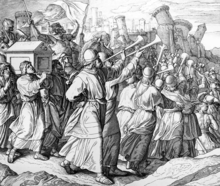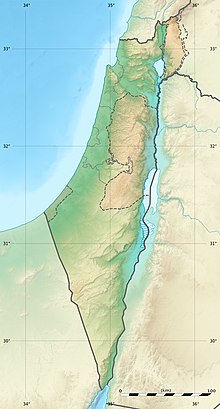| Revision as of 16:39, 17 July 2024 edit85.144.202.192 (talk)No edit summaryTags: Reverted Mobile edit Mobile web edit Disambiguation links added← Previous edit | Revision as of 16:39, 17 July 2024 edit undoZingarese (talk | contribs)Autopatrolled, Extended confirmed users, New page reviewers, Pending changes reviewers, Rollbackers13,178 editsm Reverted edits by 85.144.202.192 (talk) (HG) (3.4.12)Tags: Huggle RollbackNext edit → | ||
| Line 16: | Line 16: | ||
| | casus = | | casus = | ||
| | territory = | | territory = | ||
| | result = |
| result = Israelite victory | ||
| | combatant1 = ] | | combatant1 = ] | ||
| | combatant2 = ]ites | | combatant2 = ]ites | ||
| | commander1 = ] | | commander1 = ] | ||
| Line 26: | Line 26: | ||
| | casualties2 = ] of all inhabitants (excluding ] and her family). | | casualties2 = ] of all inhabitants (excluding ] and her family). | ||
| }} | }} | ||
| The '''Battle of Jericho |
The '''Battle of Jericho''', as described in the ] ], was the first ] fought by the ] in the course of the ]. According to {{bibleverse ||Joshua|6:1–27|HE}}, the walls of ] fell after the Israelites ] around the city walls once a day for six days, seven times on the seventh day, with the ] blowing their ] daily and the people shouting on the last day. ] at ], the ] Jericho, have failed to find any traces of a city at the relevant time (end of the Bronze Age),{{sfn|Jacobs|2000|p= 691}} which has led to a consensus among scholars that the story has its origins in the nationalist ] of much later kings of ] and their claims to the territory of the ].{{sfn |Coote|2000|p=275}} The lack of archaeological evidence and the composition, history and theological purposes of the Book of Joshua have led archaeologists like ] to characterise the story of the fall of Jericho as "invented out of whole cloth".{{sfn |Dever|2006|p=47}} | ||
| ==Biblical account== | ==Biblical account== | ||
Revision as of 16:39, 17 July 2024
Legendary battle fought by the Israelites during their conquest of Canaan For the novel by Sharon M. Draper, see The Battle of Jericho (novel).| Battle of Jericho (biblical) | |||||
|---|---|---|---|---|---|
 Depiction by Julius Schnoor von Carolsfeld (1794–1872) | |||||
| |||||
| Belligerents | |||||
| Israelites | Canaanites | ||||
| Commanders and leaders | |||||
| Joshua | King of Jericho † | ||||
| Strength | |||||
| 40,000 | Unknown | ||||
| Casualties and losses | |||||
| Nil | Massacre of all inhabitants (excluding Rahab and her family). | ||||
  | |||||
The Battle of Jericho, as described in the Biblical Book of Joshua, was the first battle fought by the Israelites in the course of the conquest of Canaan. According to Joshua 6:1–27, the walls of Jericho fell after the Israelites marched around the city walls once a day for six days, seven times on the seventh day, with the priests blowing their horns daily and the people shouting on the last day. Excavations at Tell es-Sultan, the biblical Jericho, have failed to find any traces of a city at the relevant time (end of the Bronze Age), which has led to a consensus among scholars that the story has its origins in the nationalist propaganda of much later kings of Judah and their claims to the territory of the Kingdom of Israel. The lack of archaeological evidence and the composition, history and theological purposes of the Book of Joshua have led archaeologists like William G. Dever to characterise the story of the fall of Jericho as "invented out of whole cloth".
Biblical account
According to the Book of Joshua, when the Israelites were encamped at Shittim opposite Jericho, ready to cross the river, Joshua, as a final preparation, sent out two spies to Jericho. The spies stayed in the house of Rahab, a local prostitute. The king of Jericho sent soldiers who asked Rahab to bring out the spies. Instead, she hid them under bundles of flax on the roof. After escaping, the spies promised to spare Rahab and her family after taking the city, if she would mark her house by hanging a red cord out the window.
After the Israelites crossed the Jordan, the king of Jericho ordered that the gates of the walls be closed. God commanded Joshua to go around the walls of Jericho for six days, once every day, and seven times on the seventh day. God commanded the city to be attacked by seven priests blowing horns, with the Ark of the Covenant in front of them and all the people behind the Ark of the Covenant. They encircled the wall of Jericho once a day for the first six days, and then encircled the city seven times on the seventh day. After the shofar (horn) sounded a great blow, the Israelites shouted, and the city walls fell beneath them.
Following God's law, the Israelites killed every man and woman of every age, as well as the oxen, sheep, and donkeys. Only Rahab, her parents, brothers and all "those who belonged to her" were spared. They were incorporated into Israel. Joshua then cursed anybody who rebuilt the foundations and gates, with the deaths of their firstborn and youngest child respectively. This was eventually fulfilled by Hiel the Bethelite under King Ahab's reign.
Origins and historicity

Excavations at Tell es-Sultan
In 1868, Charles Warren identified Tell es-Sultan as the site of biblical Jericho. Ernst Sellin and Carl Watzinger excavated the site between 1907 and 1909 and in 1911, finding the remains of two walls which they initially suggested supported the biblical account of the Battle of Jericho. They later revised this conclusion and dated their finds to the Middle Bronze Age (1950–1550 BCE). In 1930–1936, John Garstang conducted excavations there and discovered the remains of a network of collapsed walls which he dated to about 1400 BCE. Kathleen Kenyon re-excavated the site over 1952–1958 and demonstrated that the destruction occurred at an earlier time, during a well-attested Egyptian campaign against the Hyksos of that period, and that Jericho had been deserted throughout the mid-late 13th century BCE, the supposed time of Joshua's battle. Sources differ as to what date Kenyon instead proposed; either c. 1500 BCE or c. 1580 BCE. Kenyon's work was corroborated in 1995 by radiocarbon tests which dated the destruction level to the late 17th or 16th centuries BCE. A small unwalled settlement was rebuilt in the 15th century BCE, but it has been agreed that the tell was unoccupied from the late 15th century until the 10th/9th centuries BCE.
More recently, Lorenzo Nigro from the Italian-Palestinian Expedition to Tell es-Sultan has argued that there was some sort of settlement at the site during the 14th and 13th centuries BCE. He states that the expedition has detected Late Bronze II layers in several parts of the tell, although its top layers were heavily cut by levelling operations during the Iron Age, which explains the scarcity of 13th century materials. Nigro says that the idea that the Biblical account should have a literal archaeological correspondence is erroneous, and "any attempt to seriously identify something on the ground with biblical personages and their acts" is hazardous.

A minority of scholars maintain that the biblical account is historical and that an Israelite conquest of Jericho may have occurred around the 13th century BCE, but the strong consensus among scholars is that the Book of Joshua holds little historical value. Its origin lies in a time far removed from the times that it depicts, and its intention is primarily theological in detailing how Israel and her leaders are judged by their obedience to the teachings and laws (the covenant) set down in the Book of Deuteronomy. The story of Jericho and the rest of the conquest represents the nationalist propaganda of the Kingdom of Judah and their claims to the territory of the Kingdom of Israel after 722 BCE; and that those chapters were later incorporated into an early form of Joshua likely written late in the reign of King Josiah (reigned 640–609 BCE), and the book was revised and completed after the fall of Jerusalem to the Babylonians in 586, and possibly after the return from the Babylonian exile in 538.
See also
- Ai (Bible)
- Biblical archaeology
- "Joshua Fit the Battle of Jericho", African-American spiritual about the battle
References
- Joshua 4:13
- ^ Jacobs 2000, p. 691.
- ^ Coote 2000, p. 275.
- Dever 2006, p. 47.
- Wagemakers 2014, pp. 122ff.
- Wagemakers 2014, pp. 122–124.
- ^ Dever 2006, pp. 45–46.
- ^ Bruins & van der Plicht 1995, p. 213.
- Nigro 2020, p. 202.
- Nigro 2020, pp. 202–204.
- Nigro 2020, p. 204.
- Sims, Eleanor (2002). Peerless images : Persian painting and its sources. New Haven : Yale University Press. pp. 293–294. ISBN 978-0-300-09038-3.
- "Hermitage Museum".
- Gorelik, Michael (1979). "Oriental Armour of the Near and Middle East from the Eighth to the Fifteenth Centuries as Shown in Works of Art", by Michael Gorelik, in: Islamic Arms and Armour, ed. Robert Elgood, London 1979. Robert Elgood.
- Hawkins, Ralph K. (2013). How Israel Became a People. Abingdon Press. pp. 91ff. ISBN 978-1-4267-5543-9.
- Firth, David G. (2021). Joshua: Evangelical Biblical Theology Commentary. Evangelical Biblical Theology Commentary (EBTC) (illustrated ed.). Lexham Press. pp. 129–130. ISBN 978-1-68359-440-6.
he did find some evidence of limited occupation of the site, which is actually consistent with the testimony of the text. There is considerable erosion of the site from this period, and if mud brick construction was used, we would not expect to find significant remains. However, there was a significant central house apparently occupied in the Late Bronze Age and some ash, which suggests destruction in this period too.
- Killebrew 2005, p. 152.
- Creach 2003, pp. 9–10.
- Laffey 2007, p. 337.
- Creach 2003, pp. 10–11.
Bibliography
- Bruins, Hendrik J.; van der Plicht, Johannes (1995). "Tell Es-Sultan (Jericho): Radiocarbon Results…" (PDF). Radiocarbon. 37 (2). Proceedings of the 15th International ¹⁴C Conference: 213–220. doi:10.1017/S0033822200030666.
- Coote, Robert B. (2000). "Conquest: Biblical narrative". In Freedman, David Noel; Myers, Allen C. (eds.). Eerdmans Dictionary of the Bible. Eerdmans. ISBN 978-9053565032.
- Creach, Jerome F.D. (2003). Joshua. Westminster John Knox Press. ISBN 978-0664237387.
- Dever, William G. (2006). Who Were the Early Israelites and Where Did They Come From?. Eerdmans. ISBN 978-0802844163.
- Jacobs, Paul F. (2000). "Jericho". In Freedman, David Noel; Myers, Allen C. (eds.). Eerdmans Dictionary of the Bible. Eerdmans. ISBN 978-9053565032.
- Killebrew, Ann E. (2005). Biblical Peoples and Ethnicity: An Archaeological Study of Egyptians, Canaanites, and Early Israel, 1300–1100 B.C.E. Society of Biblical Literature. ISBN 978-1589830974.
- Laffey, Alice L. (2007). "Deuteronomistic history". In Espín, Orlando O.; Nickoloff, James B. (eds.). An introductory dictionary of theology and religious studies. Liturgical Press. ISBN 978-0814658567.
- Moore, Megan Bishop; Kelle, Brad E. (2011). Biblical History and Israel's Past. Eerdmans. ISBN 978-0802862600.
- Nigro, Lorenzo (2020). "The Italian-Palestinian Expedition to Tell es-Sultan, Ancient Jericho (1997–2015)". In Sparks, Rachel T.; Finlayson, Bill; Wagemakers, Bart; SJ, Josef Mario Briffa (eds.). Digging Up Jericho: Past, Present and Future. Archaeopress Publishing Ltd. ISBN 978-1789693522.
- Wagemakers, Bart (2014). Archaeology in the 'Land of Tells and Ruins': A History of Excavations in the Holy Land Inspired by the Photographs and Accounts of Leo Boer. Oxbow Books. ISBN 978-1782972464.
External links
 Media related to The Battle of Jericho at Wikimedia Commons
Media related to The Battle of Jericho at Wikimedia Commons
| The Bible and warfare | ||||||||||||
|---|---|---|---|---|---|---|---|---|---|---|---|---|
| Hebrew Bible battles |
|  | ||||||||||
| Bible Portal | ||||||||||||